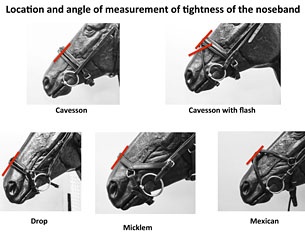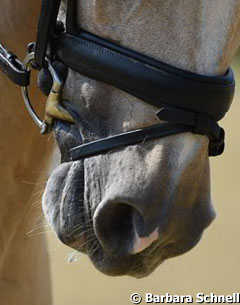
Based on results from a comprehensive study on riding equipment and tack, the Board of the Danish Equestrian Federation has decided to impose a limit to the tightness of the noseband for competition horses applicable to all disciplines as of 1 January 2018.
The study shows a clear correlation between tight nosebands and the presence of mouth lesions. The Danish equestrian federation has stated that we do not want the use of equipment in the sport to cause lesions in the horse’s mouth."
The tightness of the nosebands will be measured as of 1 January 2018: There must be room for a certified measurement unit in between the nasal plate of the horse (bony surface) and the noseband equivalent to a diameter more than 1,5cm. The rule is applicable for all disciplines.
During the rest of 2017, selected Technical Delegates will test measurement methods and perform sample measurements of noseband tightness at events. This is done to test and adapt the measurement method and to make sure both officials and riders/horses, through dialogue and in co-operation with each other, can get used to the procedure. No sanctions will be imposed in 2017.
Noseband Tightness Checked at Competitions as of 2018
From 1 January 2018, officials will check the tightness of the noseband at competitions, when there is a suspicion that the noseband is too tight. The aim is to ensure that riding at competitions always takes place with sufficient governance of horse-welfare.
If officials find that a noseband is too tight, the rider will be asked to loosen it according to the rules, after which the competitor can participate in the competition. If the rider refuses to loosen the noseband, or if there are repeated violations of the noseband tightness rules sanctions will be imposed.
The Study
 In 2014, the Danish Equestrian Federation launched a comprehensive scientific study to record the various types of riding equipment and tack used on competition horses and to clarify the impact of the equipment on the horses.
In 2014, the Danish Equestrian Federation launched a comprehensive scientific study to record the various types of riding equipment and tack used on competition horses and to clarify the impact of the equipment on the horses.
The purpose of the study was to gather evidence-based knowledge that can form the basis for governance of the horses, development of regulations and contributions to research in the future.
The study is designed and funded as a scientific project that will be published in a scientific journal. The publication will contain details and conclusions from the full study and is expected to be published by the end of 2017.
Measurement Methods
Traditionally, the noseband has been measured with "one" or "two" fingers, and different types of noseband measurement devices have also been developed.
During the rest of 2017 measurement methods and devices will be tested to be able to introduce an easily reproducible method according to the metric scale.
To ensure reproducibility the measurement device will have a specified diameter. The measurement will always be performed between the nasal plate of the horse (solid support) and the noseband. There must be room for a unit of measurement equal to more than 1.5 cm in diameter between the nasal plate and the noseband.
The rule applies to all types of nosebands, both upper and lower nosebands. Examples of measurement angles, see illustration.
What did the study show?

The following are excerpts from the study, for which more than 3000 horses were examined in the disciplines dressage, show jumping, eventing and endurance. Detailed results will be published later in the official scientific publication.
Bit, noseband and the mouth of the horse
In the study, the type of bit and noseband was recorded, the tightness of the noseband was measured and the corners of the horse's mouths were inspected for lesions and blood (oral lesions at the commissures of the lips). A proportion of the horses were recorded having oral lesions, most of them in dressage.
The tightness of the noseband showed a very clear correlation to the occurrence of oral lesions. The tighter the noseband was, the more oral lesions were recorded. Horse/rider combinations at higher level of competition had a higher prevalence of oral lesions than at lower level.
Based on these findings the regulation of noseband tightness is found to be an important focus area in the aim of reducing the frequency of oral lesions findings in competition horses at all levels.
The study results will concurrently be used to educate trainers, riders and judges to assess a naturally active mouth on competition horses and horses in training.
Spurs and the ribcage of the horse
In the study a low proportion of horses were recorded having spur associated lesions or worn hair at the ribcage. The study indicated that spurs are technically more difficult to use correctly for riders riding at a low level of competition compared to riders riding at a higher level of competition.
 For all riders, regardless of level, a relatively longer spur presented a significantly greater risk of finding hair on the spur and worn hair on the horse ribcage compared to a shorter spur.
For all riders, regardless of level, a relatively longer spur presented a significantly greater risk of finding hair on the spur and worn hair on the horse ribcage compared to a shorter spur.
We are pleased that the occurrence of lesions caused by spurs was relatively low, but we will use the results and the correlations found as a tool for future control of equipment and training of the riders.
Whip and the shoulder and hindquarter of the horse
The study revealed very few recordings of lesions due to use of the whip. The horses were inspected for lesions at the shoulder and hind quarters (swelling and skin lesions).
We are pleased that the incidence of lesions due to use of whip was very low, but we are also aware that individual cases of lesions must be identified and addressed at the events.
 It is our ambition to let this study contribute to scientific evidence based knowledge of the effect of tack and riders equipments on the horses. The study is therefore intended and financed as a scientific study that will be published in a scientific journal. The scientific publication will contain all relevant details and conclusions.
It is our ambition to let this study contribute to scientific evidence based knowledge of the effect of tack and riders equipments on the horses. The study is therefore intended and financed as a scientific study that will be published in a scientific journal. The scientific publication will contain all relevant details and conclusions.
The study is conducted by the Danish Equestrian Federation. Veterinary Consultant, and FEI National head Veterinarian, Mette Uldahl (DVM, Cert. Equine Diseases) has been in charge of the research project.
Photos © Astrid Appels - Barbara Schnell
Related Links
An Investigation into Noseband Tightness Levels on Competition Horses
Noseband Special: Part I: The History of the Noseband
Noseband Special: Part II: The Purpose of the Noseband
Noseband Special: Part III: Riders and Trainers on Their Choice in Noseband
Noseband Special: Part IV: The Thicker, the Wider, the Better?
The Use of Nosebands in Equitation and the Merits of an FEI Equestrian Welfare and Safety Committee
ISES Suggest to Empower FEI Stewards to Control Tightness of Noseband